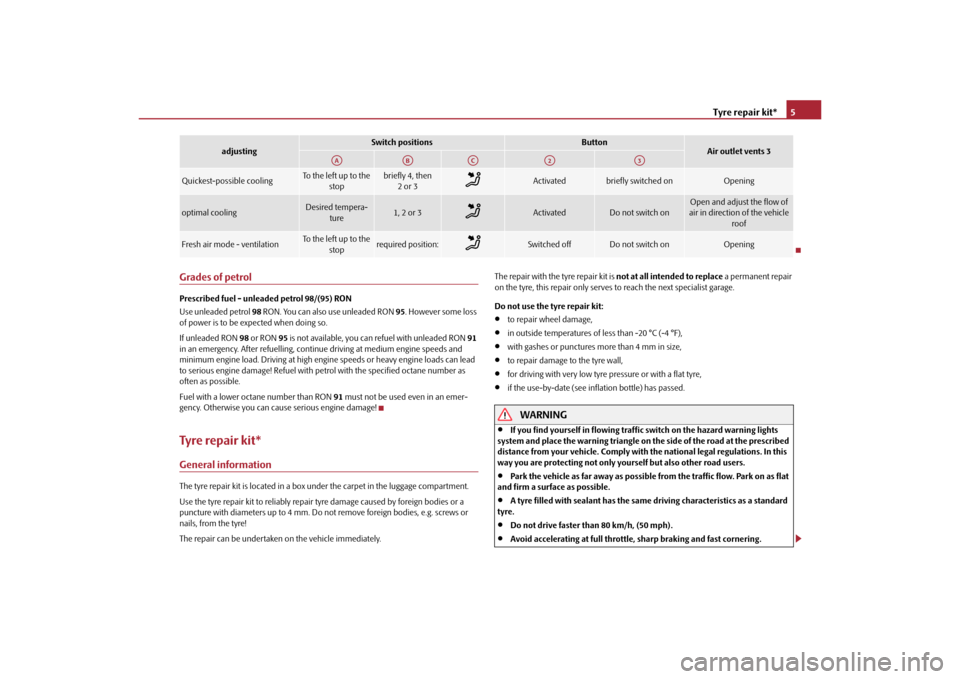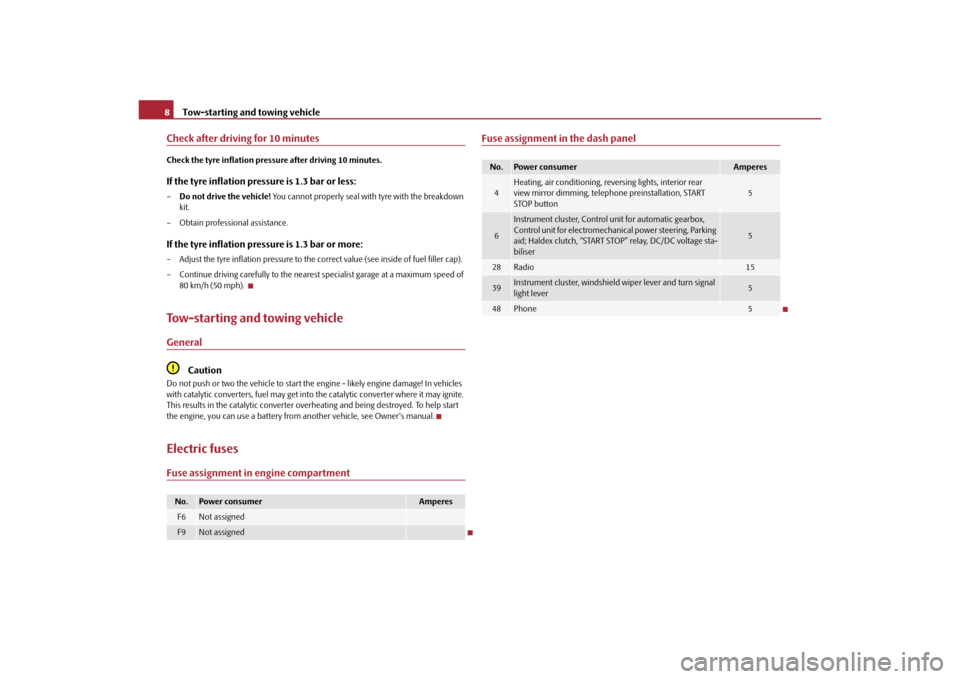fuel pressure SKODA OCTAVIA 2010 2.G / (1Z) Technical Change
[x] Cancel search | Manufacturer: SKODA, Model Year: 2010, Model line: OCTAVIA, Model: SKODA OCTAVIA 2010 2.G / (1Z)Pages: 22, PDF Size: 0.95 MB
Page 6 of 22

Tyre repair kit*5
Grades of petrolPrescribed fuel - unleaded petrol 98/(95) RON
Use unleaded petrol 98 RON. You can also use unleaded RON 95. However some loss
of power is to be expected when doing so.
If unleaded RON 98 or RON 95 is not available, you ca n refuel with unleaded RON 91
in an emergency. After refuelling, conti nue driving at medium engine speeds and
minimum engine load. Driving at high engine speeds or heavy engine loads can lead
to serious engine damage! Refuel with pe trol with the specified octane number as
often as possible.
Fuel with a lower octane number than RON 91 must not be used even in an emer-
gency. Otherwise you can ca use serious engine damage!Tyre repair kit*General informationThe tyre repair kit is located in a box und er the carpet in the luggage compartment.
Use the tyre repair kit to reliably repair tyre damage caused by foreign bodies or a
puncture with diameters up to 4 mm. Do no t remove foreign bodies, e.g. screws or
nails, from the tyre!
The repair can be undertaken on the vehicle immediately. The repair with the tyre repair kit is
not at all intended to replace a permanent repair
on the tyre, this repair only serves to reach the next specialist garage.
Do not use the tyre repair kit:
•
to repair wheel damage,
•
in outside temperatures of less than -20 °C (-4 °F),
•
with gashes or punctures more than 4 mm in size,
•
to repair damage to the tyre wall,
•
for driving with very low tyre pressure or with a flat tyre,
•
if the use-by-date (see inflation bottle) has passed.
WARNING
•
If you find yourself in flowing traffic switch on the hazard warning lights
system and place the warning triangle on the side of the road at the prescribed
distance from your vehicle. Comply with the national legal regulations. In this
way you are protecting not only yourself but also other road users.
•
Park the vehicle as far away as possible from the traffic flow. Park on as flat
and firm a surface as possible.
•
A tyre filled with sealant has the same driving characteristics as a standard
tyre.
•
Do not drive faster than 80 km/h, (50 mph).
•
Avoid accelerating at full throttle, sharp braking and fast cornering.
Quickest-possible cooling
To the left up to the stop
briefly 4, then 2or 3
Activated
briefly switched on
Opening
optimal cooling
Desired tempera- ture
1, 2 or 3
Activated
Do not switch on
Open and adjust the flow of
air in direction of the vehicle roof
Fresh air mode - ventilation
To the left up to the
stop
required position:
Switched off
Do not switch on
Opening
adjusting
Switch positions
Button
Air outlet vents 3
AA
AB
AC
A2
A3
s1ec.5.book Page 5 Friday, September 24, 2010 10:46 AM
Page 9 of 22

Tow-starting and towing vehicle
8
Check after driving for 10 minutesCheck the tyre inflation pressu re after driving 10 minutes.If the tyre inflation pressure is 1.3 bar or less:–Do not drive the vehicle! You cannot properly seal wi th tyre with the breakdown
kit.
– Obtain professional assistance.If the tyre inflation pressure is 1.3 bar or more:– Adjust the tyre inflation pressure to the correct value (see inside of fuel filler cap).
– Continue driving carefully to the nearest specialist garage at a maximum speed of 80 km/h (50 mph). Tow-starting and towing vehicleGeneral
Caution
Do not push or two the vehicle to start the engine - likely engine damage! In vehicles
with catalytic converters, fuel may get into the catalytic converter where it may ignite.
This results in the catalytic converter overheating and being destroyed. To help start
the engine, you can use a battery from another vehicle, see Owner's manual.Electric fusesFuse assignment in engine compartment
Fuse assignment in the dash panel
No.
Power consumer
Amperes
F6
Not assigned
F9
Not assigned
No.
Power consumer
Amperes
4
Heating, air conditioning, reversing lights, interior rear
view mirror dimming, telephone preinstallation, START
STOP button
5
6
Instrument cluster, Control unit for automatic gearbox,
Control unit for electromechani cal power steering, Parking
aid; Haldex clutch, “START ST OP” relay, DC/DC voltage sta-
biliser
5
28
Radio
15
39
Instrument cluster, windshield wiper lever and turn signal
light lever
5
48
Phone
5
s1ec.5.book Page 8 Friday, September 24, 2010 10:46 AM